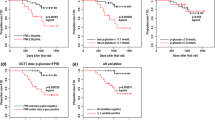Abstract
A consecutive series of 78 children with transient asymptomatic glucosuria was studied and followed up for up to 7.3 years. The age at presentation was 0.9–17.6 (median 4.6) years. One third of the patients had random blood glucose levels of >10.0 mmol/l (180 mg/dl). Five patients (6.4%) developed insulin-dependent diabetes mellitus within 2.1 years after the first incident of glucosuria. These patients presented with higher levels of glycaemia than others, and three out of five were positive for islet cell antibodies with a first-phase insulin response <46 mU/l in all four studied. Of the remaining 73 children, 3 were positive for islet cell antibodies and 12/55 had a first-phase insulin response under 46 mU/l. The insulin response deteriorated in 3 but reverted to normal in 7 patients.
Conclusion
For a child with transient glucosuria and with presence of islet cell antibodies and a subnormal first-phase insulin response, therapeutic attempts to prevent overt insulin-dependent diabetes mellitus should be considered.
Similar content being viewed by others
Abbreviations
- CF-ICA :
-
complement fication test for ICA
- FPIR :
-
first phase insulin response
- ICA :
-
islet cell antibodies
- IDDM :
-
insulindependent diabetes mellitus
- IF-ICA :
-
immune fluorescent test for ICA
- IVGTT :
-
intravenous glucose tolerance test
- OGTT :
-
oral glucose tolerance test
References
Bhisitkul DM, Morrow AL, Vinik AI, Shults J, Layland JC, Rohn R (1994) Prevalence of stress hyperglycemia among patients attending a pediatric emergency department. J Pediatr 124:547–551
Bingley PJ, Bonifacio E, Gale EAM (1993) Can we really predict IDDM? Diabetes 42:213–220
Gale EAM, Bingley PJ (1994) Can we prevent IDDM? Diabetes Care 17:339–344
Herskowitz RD, Wolfsdorf JI, Ricker AT, Vardi P, Dib S, Soelner S, Eisenbarth GS (1988) Transient hyperglycemia in childhood: identification of a subgroup with imminent diabetes mellitus. Diabetes Res 9:161–167
Herskowitz-Dumont R, Wolfsdorf II, Jackson RA, Eisenbarth GS (1993) Distinction between transient hyperglycemia and early insulin-dependent diabetes mellitus in childhood:a prospective study of incidence and prognostic factors. J Pediatr 123:347–354
Karjalainen JK (1990) Islet cell antibodies as predictive markers for IDDM in children with high background incidence of disease. Diabetes 39:1144–1150
Kuzuya H, Blix PM, Horwitz DL, Steiner DF, Rubenstein AH (1977) Determination of free and total insulin and C peptide in insulin-treated diabetics. Diabetes 26:22–29
Rajantie J, Weber T, Stenman U-H, Silvast A, Mäenpää J (1992) Elcvated HbA1 due to foetal haemoglobinaemia in children. A common artifact of certain ion-exchange chromatography methods. Scand J Clin Lab Invest 52:317–320
Robert J-J, Deschamps I, Chevenne D, Roger M, Mogenet A, Boitard C (1991) Relationship between firstphase insulin secretion and age, HLA, islet cell antibody status, and development of type I diabetes in 220 juvenile first-degree relatives of diabetic patients. Diabetes Care 14:718–723
Rosenbloom AL, Drash A, Guthrie R (1972) Chemical diabetes mellitus in childhood: report of a conference. Diabetes 21:45–49
Rosenbloom AL, Hunt SS (1982) Prognosis of impaired glucose tolerance in children with stress hyperglycemia, symptoms of hypoglycemia, or asymptomatic glucosuria. J Pediatr 101:340–344
Schatz DA, Kowa H, Winter WE, Rilley WJ (1989) Natural history of incidental hyperglycemia and glycosuria of childhood. J Pediatr 115:676–680
Surwit RS, Schneider MS, Feinglos MN (1992) Stress and diabetes mellitus. Diabetes Care 15:1413–1422
Tuomilehto J, Lounamaa R, Tuomilehto-Wolf E, Reunanen A, Virtala E, Kaprio EA, Åkerblom HK (1992) Epidemiology of childhood diabetes mellitus in Finland: background of a nationwide study of type 1 (insulin-dependent) diabetes mellitus. Diabetologia 35:70–76
Vardi P, Shehade N, Etzioni A, Herskovits T, Soloveizik L, Shmuel Z, Golan D, Barzilai D, Benderly A (1990) Stress hyperglycemia in childhood: a very high risk group for the development of type I diabetes. J Pediatr 117:75–77
World Health Organisation Expert Committee on Diabetes Mellitus (1980) Second Report. WHO Tech Rep Ser No. 646
Author information
Authors and Affiliations
Rights and permissions
About this article
Cite this article
Rajantie, J., Mäkelä, J. & Mäenpää, J. Transient incidental glucosuria in children. Eur J Pediatr 154, 811–814 (1995). https://doi.org/10.1007/BF01959787
Received:
Accepted:
Issue Date:
DOI: https://doi.org/10.1007/BF01959787




